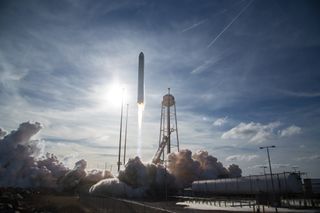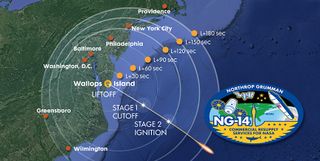Update for 9:55 pm ET, Oct. 2: NASA and Northrop Grumman successfully launched the Cygnus NG-14 mission on an Antares rocket tonight (Oct. 2). Liftoff occurred at r 9:16 p.m. EDT (0116 GMT). Read our full story here.
Original post:
People along the east coast of the United States should get a great opportunity to see a rocket launch from their own backyards tonight.
Weather permitting, observers from Massachusetts to the Carolinas could see an International Space Station-bound Cygnus spacecraft launch atop a two-stage Antares rocket tonight (Oct. 1), blasting off from NASA's Wallops Flight Facility on Wallops Island, Virginia.
NASA commercial cargo provider Northrop Grumman is launching the mission, which will deliver nearly 8,000 lbs. (3,600 kilograms) of supplies, marking the company's 14th resupply mission to the International Space Station for NASA.
Liftoff is set for 9:38 p.m. EDT (0138 GMT on Friday, Oct. 2) from Pad 0A at Wallops tonight. You can watch the launch live here and on Space.com's homepage beginning at 9 p.m. EDT (0100 GMT). You can also watch directly from NASA TV here.
In photos: See the Antares rocket's Cygnus NG-13 launch to space station
Get the Space.com Newsletter
Breaking space news, the latest updates on rocket launches, skywatching events and more!
What to expect

You can print out a NASA virtual launch passport here for tonight's launch. Register on Eventbrite for a stamp NASA will email out after the launch!
If you're in the immediate area, viewing locations on Chincoteague Island include Robert Reed Park on Main Street or Beach Road spanning the area between Chincoteague and Assateague Islands. The beach at the Assateague Island National Seashore/Chincoteague National Wildlife Refuge will not be open during the launch.
NASA has provided a visibility prediction map, but views of the rocket launch differ depending on where along the East Coast you live. The farther away you are from the launch site, the closer to the horizon the rocket will be.
As a reference, your clenched fist held at arm's length is roughly 10 degrees in width. If a skywatcher is trying to spot the launch from New York City, for instance, the highest point Antares will reach is approximately 9 degrees above the horizon.

It's unlikely that you will be able to view the launch when it's less than 5 degrees above the horizon, because buildings, vegetation and other terrain features will probably get in the way. Antares will reach 5 degrees above the horizon about 150 seconds after launch.
The Antares launch will be visible along the East Coast by virtue of the light emitted from its two stages. The first stage uses kerosene and liquid oxygen as propellants, powering two Russian-built RD-181 engines, producing more than 860,000 lbs. of thrust.
The rocket should appear as a bright, moving star. Observers who use binoculars might be able to see a tiny V-shaped contrail, which harmlessly breaks up in the atmosphere and falls into the Atlantic Ocean.
Arcing over the Atlantic Ocean, the rocket will pass the speed of sound and shut down its liquid-fueled main engines about 210 seconds after liftoff. After jettisoning its first stage, payload fairing and an interstage connecting adapter, the Antares second stage Castor 30XL solid-fueled motor will ignite to inject the 16,928 lbs. (7,678 kilograms) Cygnus spacecraft into orbit.
The second stage will appear farther downrange and at a lower elevation than where the first stage shutdown appeared. The trajectory will appear to dip back toward Earth as the rocket moves farther away from the observer and disappears beyond the horizon. But the rocket, of course, is not returning to Earth — it is continuing its ascent, speeding higher and faster toward space.
Where to concentrate your gaze

- Eastern half of South Carolina/North Carolina/Coastal Virginia: Liftoff to Stage 1 shutdown, primarily toward the northeast. Stage 2 ignition, for the Carolinas, east; coastal Virginia, southeast.
- Interior Virginia/eastern half of West Virginia: Liftoff to Stage 1 shutdown, primarily toward the east. Stage 2 ignition, southeast.
- Maryland, Delaware, Pennsylvania: Liftoff to Stage 1 shutdown, primarily south-southeast. Stage 2 ignition, southeast.
- New Jersey/Southeast New York: Liftoff to Stage 1 shutdown, south. Stage 2 ignition, southeast.
- Southern New England and Long Island: Liftoff to Stage 1 shutdown, south-southwest. Stage 2 ignition, for Western Massachusetts, Connecticut and Long Island, southeast; for eastern Massachusetts and Rhode Island, south-southeast.
About the mission
Should tonight's launch be scrubbed, the time of liftoff will fall back by roughly 23 minutes per day. As an example, a rescheduled launch attempt for Friday (Oct. 2) would come at around 9:15 p.m. EDT (0115 GMT).
If the rocket launches tonight, the Cygnus spacecraft, dubbed the S.S. Kalpana Chawla, will arrive at the space station on Sunday, Oct. 4. Expedition commander Chris Cassidy of NASA will grapple Cygnus and flight engineer Ivan Vagner of Roscosmos will act as a backup. After Cygnus capture, mission control in Houston will send ground commands for the station's robotic arm to rotate and install it on the bottom of the station's Unity module. The mission will deliver a new toilet, a crop of radishes, cancer research and virtual reality technology along with 8,000 lbs. (3,600 kg) of crew supplies and hardware.
Cygnus is scheduled to remain at the space station until mid-December. Following departure, the capsule will conduct the next installment of an ongoing experiment studying fire in space, then dispose of several tons of trash during a fiery re-entry into Earth's atmosphere approximately two weeks later.
Editor's Note: If you snap a photo of tonight's launch and would like to share it with Space.com's readers for a potential story or gallery, send your photos, comments, and your name and location to spacephotos@space.com.
Joe Rao serves as an instructor and guest lecturer at New York's Hayden Planetarium. He writes about astronomy for Natural History magazine, the Farmers' Almanac and other publications. Follow us on Twitter @Spacedotcom and on Facebook.
Join our Space Forums to keep talking space on the latest missions, night sky and more! And if you have a news tip, correction or comment, let us know at: community@space.com.

Joe Rao is Space.com's skywatching columnist, as well as a veteran meteorologist and eclipse chaser who also serves as an instructor and guest lecturer at New York's Hayden Planetarium. He writes about astronomy for Natural History magazine, the Farmers' Almanac and other publications. Joe is an 8-time Emmy-nominated meteorologist who served the Putnam Valley region of New York for over 21 years. You can find him on Twitter and YouTube tracking lunar and solar eclipses, meteor showers and more. To find out Joe's latest project, visit him on Twitter.
